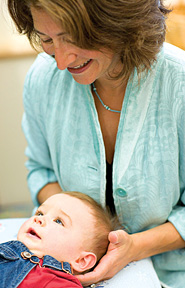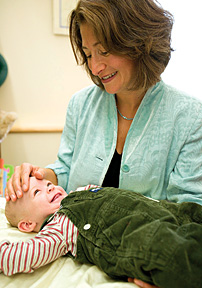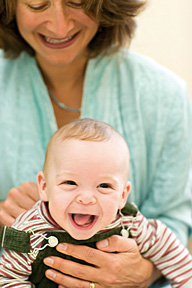|
Marlena was at her wit’s end. Her first child had been a breeze, but her second was a different story. At 6 weeks old, Cameron hadn’t slept longer than an hour at a time, was fussy when awake, had difficulty nursing and seemed to spit up more than he ate, a feat that continually perplexed his mother. Marlena had concerns about giving reflux medications to a baby so young. The pediatrician told Marlena to hang in there, that Cameron would eventually outgrow his symptoms. Marlena wasn’t sure she could last that long. Then a friend suggested she take her baby to a chiropractor. The friend said a chiropractor had helped ease her baby’s colic and had helped her baby nurse more comfortably. Marlena was skeptical, but willing to try anything. She went to a chiropractor who specializes in treating children. The chiropractor listened to Marlena’s story of her baby and the birth, and thoroughly examined her child. The chiropractor paid special attention to the joints of Cameron’s spine and cranium. After a few very gentle maneuvers to loosen joints in the baby that had gotten locked during the birth process, Marlena was amazed at the change in her son. Cameron immediately latched on to the breast more deeply and more comfortably.
How does chiropractic care work? How did the chiropractor help Cameron sleep better, nurse better and spit up less? The answer is actually simple when you understand a little about the body. When a joint in the spine or cranium doesn’t move properly (a condition called a subluxation), it has the potential to irritate the nervous system. And it’s the nervous system that runs the baby’s body, carrying instructions from the brain to distant body parts. If that communication system becomes disrupted, the affected body part may not function properly. Chiropractic care removes the source of irritation, allowing the body to heal and operate properly. In Cameron’s case, a dysfunctional joint was irritating the nerve that travels from the brain to the tongue. As a result, Cameron’s tongue did not know how to properly function during the suck-swallow cycle, causing a shallow latch that was painful for Marlena. Once the locked joint was released with a procedure called an adjustment, the nerve irritation disappeared, restoring proper communication between the brain and tongue, allowing the tongue to latch on properly (and thankfully for Marlena, painlessly as well). The same applies to Cameron’s excessive spitting up – the adjustment relieved irritation to the nerves that control the digestive tract. And because Cameron was no longer hungry and no longer had a tummy ache, not only was he able to sleep more deeply, but he was also happier and more comfortable than he’d ever been before. Is chiropractic care safe for a baby? Cameron is not alone; many children visit a chiropractor these days. Recent surveys have shown that up to 14 percent of chiropractic visits are for pediatric patients and that chiropractors are the most common non-medical provider visited by children. According to a survey by the Centers for Disease Control and Prevention (CDC), more than 2 million children visited chiropractors in 2007. In general, the chiropractic adjustment is a very safe procedure for children. With millions of children visiting a chiropractor every year, adverse events (the technical term for injury) are very rare. A study published in 2008 in the prestigious medical journal Pediatrics found only nine incidents of adverse events related to spinal adjustments in children worldwide over the past 100 years, an enviable safety record. All doctors understand that any form of health care comes with some degree of risk, whether we’re talking about a dose of antibiotics or a chiropractic adjustment. As with any procedure, your chiropractor should discuss the benefits and the risks of the adjustment as it applies to your child. Chiropractic care for children is very different than chiropractic care for adults. The adjustments are much softer and gentler because the child’s joints are looser and easier to move. The procedure is quite comfortable and children often look forward to their chiropractic treatment. In addition, children generally heal much more quickly than adults, so typically require just a few treatments to restore normal motion to their joints, and thus restore normal function to their nervous systems and related end organs. What kinds of pediatric conditions can a chiropractor help?
It’s important to remember that chiropractors are more than just back adjusters. Chiropractors are physicians whose scope of practice includes manual therapies (like adjustments and massage), physiotherapies (like ultrasound), exercise and postural advice, herbal and nutritional supplements, and lifestyle and dietary advice. After taking a thorough history and performing a complete examination, your chiropractor will determine which combination of these therapies will best help your child reach optimal health. Chiropractic physicians and medical physicians complement each other; as a team, they provide complete health care for your child. Chiropractors help children heal and attain true health by releasing joints that aren’t moving properly or to their fullest capacity. This restores natural nervous system function, correcting symptoms at the root of the problem and optimizing the child’s overall health and inherent healing abilities. Marlena found that chiropractic care helped her baby Cameron nurse better, sleep better and feel better! As a result, Marlena slept better and felt better, too! If your children aren’t already receiving regular chiropractic care, talk to your doctor about getting them into the office for an initial visit. If your chiropractor doesn’t specialize in treating children, particularly very young children, and doesn’t know someone who does, you can find a pediatric chiropractor in your neighborhood by visiting http://acapedscouncil.org/unitedstates.html or www.icapediatrics.com/members-referral.php. Common Pediatric Conditions That Respond Well to Chiropractic Care Neonate-Infant:
Toddler and Preschool-Age Child:
School-Age Child and Adolescent:
Elise Hewitt, DC, CST, DICCP, is board-certified in chiropractic pediatrics and serves as president of the American Chiropractic Association’s Council on Chiropractic Pediatrics. She practices in Portland, Ore., and is a well-recognized resource for information regarding chiropractic care of children. |


